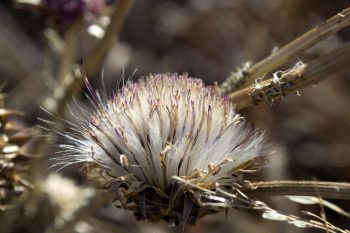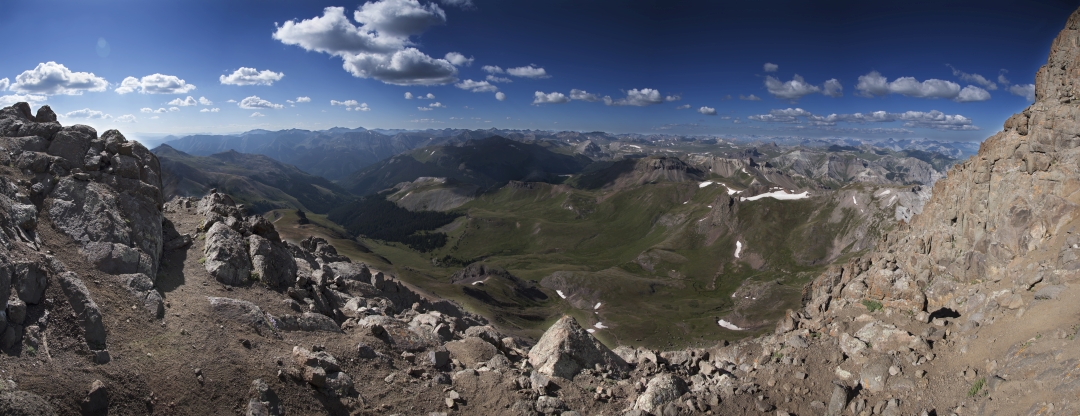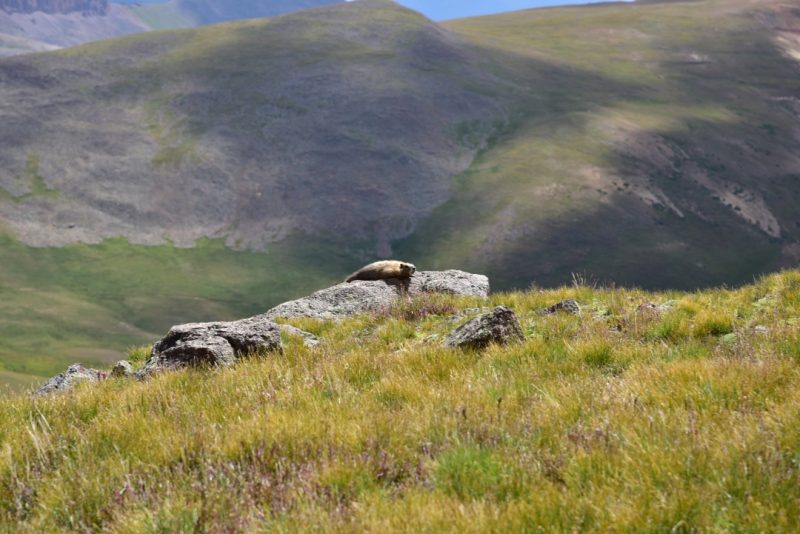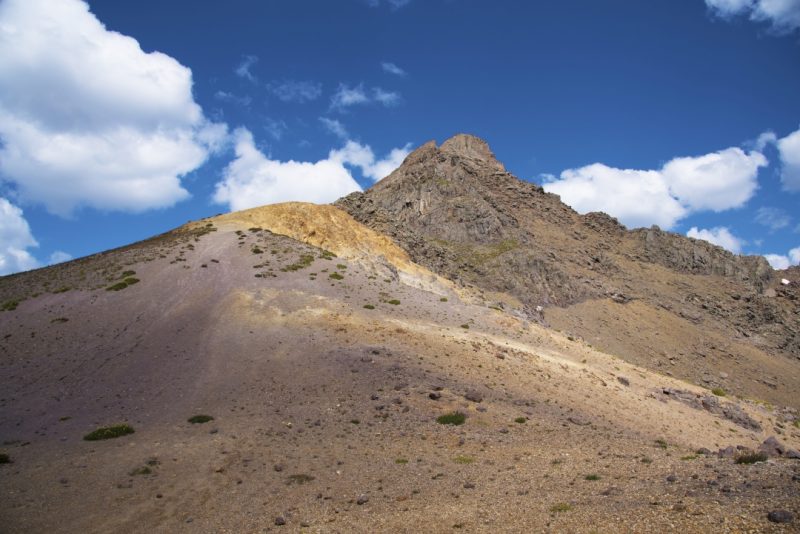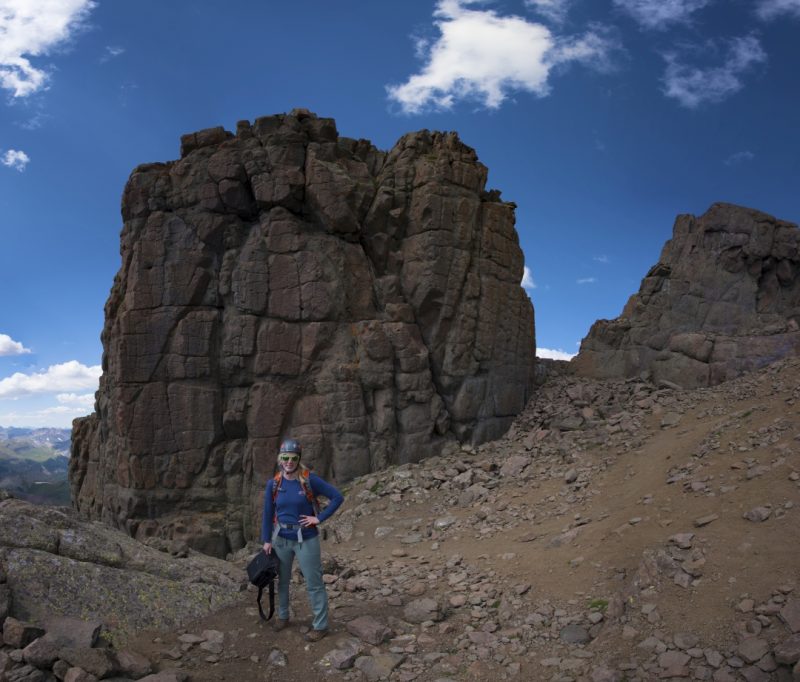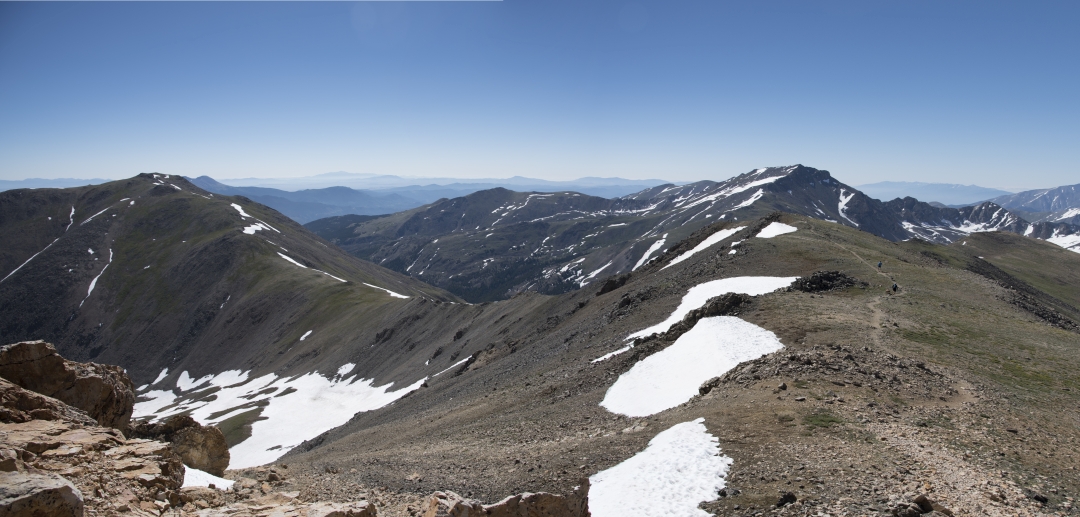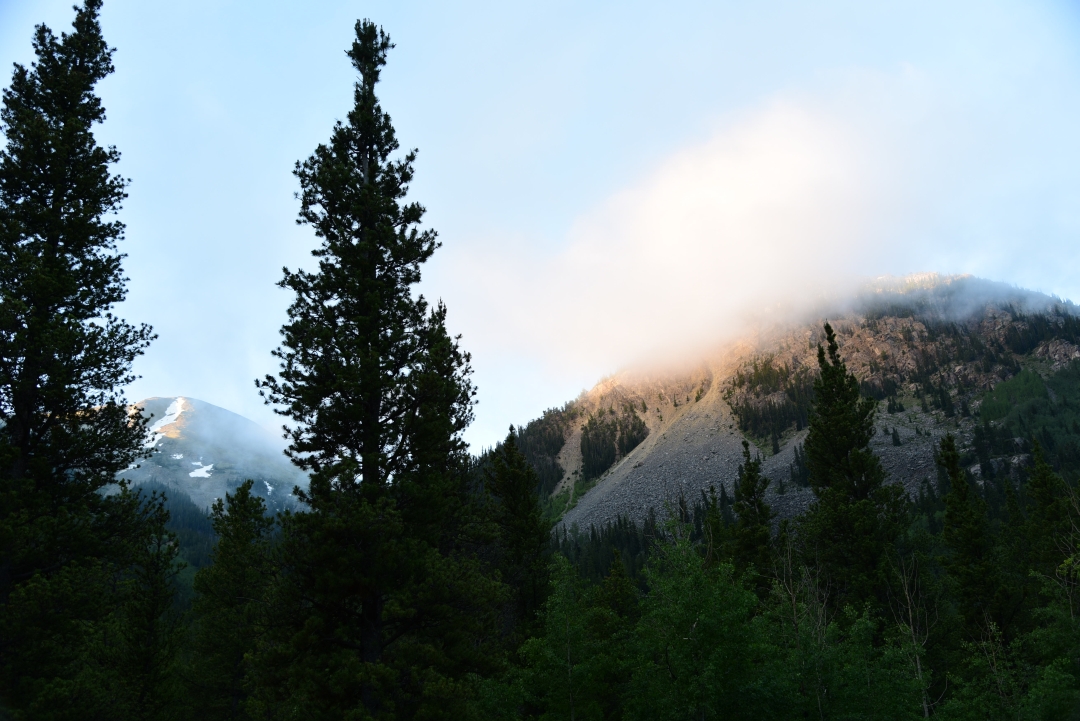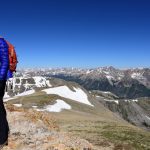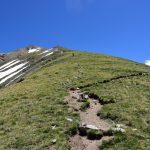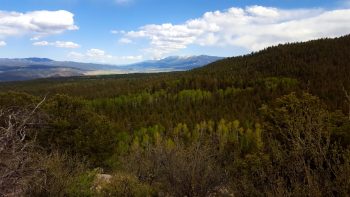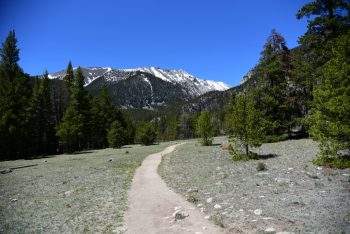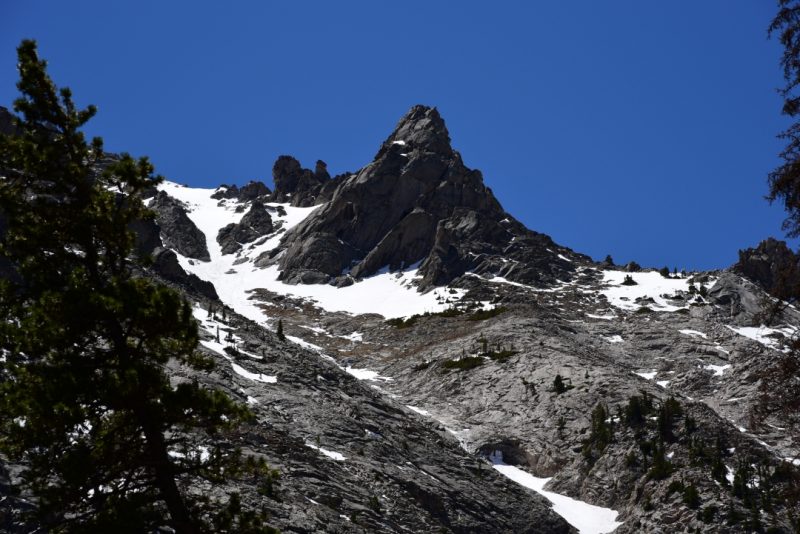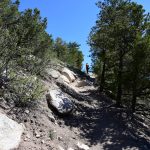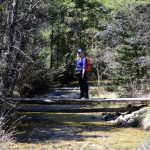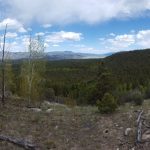Take a Walk
A Quest into the Wild
Wetterhorn Peak, San Juan Range (14,015 ft)

On August 17th of last week, we decided to climb Wetterhorn peak. You might be thinking…”you went to Switzerland!?” But, no in fact, we made a relatively easy 5 hour drive to the San Juan Range of Colorado and set up “camp” in Lake City, Colorado. The 14er Wetterhorn in Colorado is named after its European counterpart in the Bernese Alps. Members of the 1874 Hayden Geological Survey recognized similarities between the distinctive summits of these peaks. Though more photographed, Swiss Wetterhorn only reaches 12,000 feet compared to our Wetterhorn at just over 14,000 feet. Our peak is is probably less photographed due to the relatively hidden nature of our peak in the rugged San Juans.
We say “camp” loosely as we stayed comfortable and dry in the Cannibal Cabins in Lake City to get some adequate rest. We’ll get to the name later, and the town’s odd obsession with a fellow named Alfred Packer. Our alarm went off at 4:45 am, and we quickly gathered our gear in the cold, dark morning. Though warmer than outside, we failed to turn the heat on in the cabin during the night and woke up to a crisp chill as we donned our climbing clothing. We hit the alpine loop in the dark and followed the gravel road for 9 miles before turning off onto the 4-wheel drive road, North Henson Creek Rd. Thankfully, the sun began to rise once we reached this terrain. The first two miles were relatively tame, but the final 0.7 mile to the upper trailhead was rough and narrow. It should be noted that there is some parking below this final section for vehicles that don’t have enough clearance. We were just fine in a stock Xterra though careful negotiation was required in two to three sections.
We began our ascent of Wetterhorn around 6:30 am and hiked easy terrain for the first 0.75 miles or so to a junction where we went right. We passed through some trees and saw a few campsites before the trail opened up to a gentle hillside. Around 12,000 feet, we reached another junction and followed the trail left towards Wetterhorn peak. At this point, we still had the trail completely to ourselves. It was so quiet and serene in the remoteness of the San Juans.
We continued to gain elevation, though it felt really gradual on this portion of the trail. As we reached a boulderfield, the terrain got a bit steeper, and the marmots began to make their presence known. They popped up amid the rocks and flora and stared us down. We also saw a chubby little Pika scurry in our path, its mouth full of a collection of various grasses. It was fun to see so much wildlife on the hike, however we were told by folks in town that these little critters (marmots) enjoy chewing the straps off of day packs and the handles off of hiking poles whenever you let your guard down. In between all the critters, we looked up and were greeted with outstanding views of our objective.
We continued upward through rocky terrain and reached the ridge to the summit and the “yellow” dirt that marks the start of the more difficult terrain. The yellow dirt was a collection of loose dirt and scree and not very enjoyable to ascend (descending it was worse). We quickly worked our way past the dirt to reach the part of the climb we had most been looking forward to: the class three terrain. Here, we were at approximately 13,200 feet and had less than a mile to the summit. We navigated the left side of the ridge on a faint, broken trail through difficult class 2 terrain before reaching our first class three climbing. We reached a “rock rib” which blocks easy passage. We climbed upward and bypassed it via a v notch on the left. It was easy, but fun climbing, and the notch was not difficult to spot, though we studied pictures of the terrain in detail before our attempt. There is also another option for bypassing this feature that we utilized on the way down. Instead of going through the v-notch, you can also climb over some rocks to reach the ridge crest. Both options were fun. Most this portion of the climb can be seen in our go-pro video as we really needed our hands and couldn’t take many photos.
Once on the ridge crest we continued towards the “prow,”. A distinctive feature of this climb, the prow is a towering fin-like rock feature that mimics the prow of a ship. On the ridge crest, we stayed as high as possible and climbed over more class 3 rock to reach the area next to the prow. There was a faint trail skirting the left side of the ridge, but the rock was loose, and the bits of path filled with scree. At 13,800 feet, we walked passed the right side of the prow. Near the prow is a flat area to rest and chill out at if one is so inclined, instead of the continuing onward to the exposed final route to the summit.
We continued past the prow to two notches leading to an open area below the summit block we can be seen above in the photo on the left. We climbed up and through this obstacle to reach a polished rock ramp slanting downward to a narrow ledge that marks the start of the over 150 foot “staircase” to the summit. The exposure here is quite intense but the rock is stable and climbing relatively easy. Essentially, it is a series of knee to thigh high ledges with plenty of solid handholds. Both of us wore helmets, as rock fall could potentially be a hazard from climbers above. Seen below is the ramp leading to the most exciting part of the climb and the exposure looking back behind it once you have reached the ledge to start the climb.
Our video we made of this hike begins here at “the Prow.” Check it out below!
About halfway up, the crux of the route mimics an amphitheater with several wider ledges in an arc shape facing the vast terrain. Here, we followed a narrow ledge towards the left and then proceeded to climb the final 50 feet up slightly easier terrain. The photos below are from climbing up the staircase. We popped up on the summit and joined two other climbing groups.
 We spent about 15 minutes enjoying the truly amazing views of the Uncompahgre Wilderness and the rest of the San Juan range. The colors were amazing. Bright green grass, red and yellow rock, and a brilliantly blue sky peppered with fluffy white clouds filled our vision in all directions. Despite enjoying our accomplishment and the wonderful scenery, the nagging thought of the down climb kept plaguing us. We waited for the other groups to safely descend the peak before we started down. The first 50 feet down towards the ledge didn’t require us to face inward to the rock, but after we reached the ledge and area that looked like an amphitheater, we faced inward to safely reach the bottom of the stairs. The downclimb felt harder than climbing up, but we managed just fine and reached the slanted slab in no time. Once we were on less exposed terrain near the prow, we paused for some food and photos that some fellow climbers took for us.
We spent about 15 minutes enjoying the truly amazing views of the Uncompahgre Wilderness and the rest of the San Juan range. The colors were amazing. Bright green grass, red and yellow rock, and a brilliantly blue sky peppered with fluffy white clouds filled our vision in all directions. Despite enjoying our accomplishment and the wonderful scenery, the nagging thought of the down climb kept plaguing us. We waited for the other groups to safely descend the peak before we started down. The first 50 feet down towards the ledge didn’t require us to face inward to the rock, but after we reached the ledge and area that looked like an amphitheater, we faced inward to safely reach the bottom of the stairs. The downclimb felt harder than climbing up, but we managed just fine and reached the slanted slab in no time. Once we were on less exposed terrain near the prow, we paused for some food and photos that some fellow climbers took for us.
The remaining downclimb was uneventful, but nonetheless enjoyable minus the “yellow” rock section. Once off the ridge, we took our time getting back to the truck and took many photographs and enjoyed our time in the backcountry. On our way back, features that were hidden in the darker morning appeared to us more clearly. Several of the creeks we hiked by appeared a unique whitish blue color that can been seen below. We are still in the midst of researching why the water and rocks are so uniquely hued and will update at a later time.
We reached our truck, ready for some food and relaxation. Despite the relatively short hike and climb (approximately 7 miles RT, and 3,300 feet of elevation gain), tiredness set in. The peak was, after all, a bit mentally taxing with all the exposure. It took us about 45 minutes to get back to Lake City where we stopped at Southern Vittles for some amazing food. (Just about everyone in Lake City is from Texas) so they know good food.
Wetterhorn peak was an extremely fun class 3 climb with spectacular views. It provided much needed adventure and a step up from an everyday hike. Nonetheless, those attempting it should be comfortable with class 3 climbing and enjoy great exposure. There is a also a bit of route finding necessary on this peak to keep the terrain on the easy side.
Now, back to the “cannibal” cabins thing. Way back in 1874, good ole Alfred Packer (an American prospector) attempted to travel through the southwestern colorado mountains in an extremely harsh winter. Essentially, he took 5 men with him and only he returned to Lake City. He at first claimed that the group left him, but inconsistencies in his story emerged and eventually he admitted to living off the flesh of his companions to survive. Apparently the remains of the men in his group were found just outside of Lake City, and the town can’t seem to shake this event. There is a restaurant called Cannibal Grill and Packer Saloon and of course our cabins. Despite the creepy name, the restaurant and saloon are really fun with great food and an amazing patio with live music. The cabins are quaint and clean.
Stay tuned for our a trip report from our second peak of the trip, Handies Peak.
Mount Belford (14,197 ft) and Mount Oxford (14,153 ft): Sawatch Range

Distance: 11.2 miles Net elevation gain: 5,800 ft Date of summit: 6/24/17
As the day began to settle into dusk, we reached our destination for this quiet June Friday night. The dimly lit Rodeway Inn sign tiredly welcomed us to rest a few hours. Like many summer and early fall evenings before, we left the night before our summit attempt to get closer to the trailhead for an alpine start. Though the Rodeway Inn was unassuming, it was clean and comfortable and gave us a bit more rest than our three season tent could have in the cold mountain air at 9,800 feet. Our goal for Saturday morning was to reach the summits of 14ers Mount Belford and Mount Oxford which are both accessible from the Missouri Gulch TH. In late summer of last year, we followed the gulch trail up and took the trail to Missouri Mountain instead of following it to the left towards Belford. This time, we planned to complete the trio of mountains. At 4:30 am, the alarm sounded in the dark, and we quickly grabbed our gear and headed out in the cool, dark early morning hours. Just as the sun began to softly illuminate the landscape, we pulled into the last parking spot at the TH, grabbed our packs, and began the steep ascent through the Missouri Gulch.
Oh how time cultivates our memories, often times erasing the bad and replacing it with only the fondness of our adventures. The climb through Missouri Gulch is steep and offers very few breaks from the relentless gain in altitude. Familiarity quickly flooded back, as we warmed our bodies in the cool morning air with all of our hard work. We reached the creek crossing rather quickly, but were a little surprised to see how high the water was and how unstable the log crossing appeared. Last September, all the snow had melted many weeks before, and the water was calm. Ever so carefully we balanced on the maze of floating timber until we safely reached the other side. A fall in the creek would have erased all of our summit hopes for the day.
We made quick work of the trail at this point and stumbled upon the old log shack remnants just before our route opened up from the forest. We were now at about 11,300 feet, and we followed the trail along clear creek to the Belford/Elkhood pass trail junction. This portion of the route offers a nice break from the steep terrain and forest-dense switchbacks that we had spent the previous hour plodding up. The cool morning air and sounds of the nearby creek treated us spectacularly, and we reveled in the beauty of our surroundings. At the junction, we veered left towards Belford and saw the work that lay ahead of us. Checking our GPS, we realized that at the base of Belford’s northwest ridge we still had around 2,300 feet of elevation to gain in a mere 1.7 or so miles. We crossed a small creek and mentally prepped for the grueling ascent. We crossed several small, never-ending switchbacks on a primarily solid trail. There were however, several sections of steep scree that proved more difficult on the descent. At some points, the steepness of the route warranted rock stair steps to aid in the journey. Though tiring and difficult, we made decent time of our ascent up Mount Belford. Seen below is the final 2,300 feet to Belford’s summit and the beautiful Missouri Gulch. Note that the true summit of Belford is hidden in the photographs below. A tricky false summit dashed our spirits for a moment when we discovered its deceit.
The summit block of Belford is comprised of an interesting sharp and jagged yellow/orange rock. The block isn’t too large, but provides room for a few climbing parties in close proximity. We relaxed on the summit for around 15 minutes, chatting with other climbing parties and identifying all the other 14ers in proximity. Missouri Mountain was still covered in snow, and Harvard looked brooding in the distance. We saw our next goal, the summit of Mount Oxford in the distance. We now began to realize the true magnitude of the elevation gain we had agreed to take on in this adventure. Just to reach Belford, we had already climbed 4,600 feet. Other climbers we were chatting with said that the second summit would give us a bit more gain..another 1200 feet…We had come all this way, and we were only 1.5 miles away. We had to give it a shot. Seen below are photos from the summit of Belford when we were still enjoying life and in high spirits. You can see the summit of Oxford and the seemly innocent trail to the summit. These photos do not reveal the steep descent that occurs from Belford to reach the saddle.
We began the descent to the saddle in high spirits but began to get nervous when we realized how much elevation we were losing to reach the saddle between the peaks. Further, there were several extremely steep scree laden sections to navigate. Nonetheless, the trail was easy to follow and began even somewhat pleasant as we reached the saddle and began to make our way up Mount Oxford. Despite this, we began to get really tired as we ascended our second peak. About half-way up Oxford, we paused before a short but deep snowfield to catch our breathe. After a 5 minute rest, we carefully navigated the small, steep snowfield and made it to the summit of Oxford relatively quickly. There were only two other climbers whom we shared the wide summit. Seen below are views from the trek to Mount Oxford and the perspective from the summit.
We rested for another 15 minutes on the summit of Oxford. Though it felt like a major accomplishment to be sitting atop our second point above 14,000 feet for the day, we still had to get back up the steep ridge to Belford before we could truly begin our descent. We inhaled water and trailmix, letting the energy creep back in before we turned back. The sky still remained a perfect blue with naught a cloud in sight at noon, so we felt comfortable taking our time in the return. The start back up to Belford begins gradually and gave us a brief moment of confidence. The last 300 feet were brutal, but at least the array of alpine flora kept our eyes from focusing too much on the vertical path. We were thrilled upon reaching the ridge and short stretch back to Belford. After sitting on Belford for the second time that day, we realized that we had gained about 5,800 feet of elevation. Though we knew it would be a long trek for the day, somehow that number escaped us when we were researching this climb. Seen below are photographs looking back at the path back to the summit of Belford from Oxford and from the Summit of Belford looking back towards the gulch.
As we descended around 1:00 pm, there were several more hiking parties coming up late, enjoying this rare perfect summer weather day. At this point, we were exhausted to the point where gatoraide, trail mix, and water were doing little to nothing to improve our energy levels or morale. Though the descent was easier with respect to cardio, our leg muscles were shaking with fatigue as we navigated the steep scree trail back to the valley. The sun was high in the sky now, and it was quite warm. Despite being in this sublime place, we were really ready to reach the trailhead and our truck. Interestingly, the trek down seemed much longer than the trek up. We couldn’t believe that we had climbed all of this in the morning. At least, we were afforded a few, new spectacular views on our descent that can be seen below.
We were grateful for the forest canopy when we reached the Clear Creek crossing. It was nice to be shielded from the intensity of the sun. We were now on a mission to get off the mountain and back to the car. The camera went back in the pack, and we made very quick descent through the seemingly endless switchbacks through the forest. When we heard the familiar roar of the white water of the river crossing and bridge, we were so ecstatic. We were back at the TH! We drove a short while down the road to the Clear Creek reservoir and dipped our feet in the freezing cold water. A weight was lifted from our minds and bodies as we relaxed for a few moments before the drive back to Denver. We had successfully reached the summits of our 18th and 19th Colorado fourteeners, the first of this season. But who’s counting anyway.
Browns Creek Waterfall and Lake: Nathrop, CO

Miles: 12.11 (Out and Back) Min Elevation: 8,918 ft Max Elevation: 11,309 ft Total Elevation Gain: 2440 ft Net Elevation Gain: approx. 2,391
Memorial day was finally upon us this year, marking the quintessential start to summer and the brilliant array of activities that accompany this change in season. However, while Denver was awash in bright sunlight or bathed with warm rain for most of the month, the high country in Colorado continued to get blanketed by late season snow of the wet and heavy variety. May 29th marked our 7th wedding anniversary, and despite no promise of prime conditions, we were determined to seek refuge in the mountains to celebrate. On Saturday May 27th, we piled into the truck on little sleep and headed southwest towards Salida, CO in the hopes of bagging Mount Shavano and kicking off the climbing season early. Due to a little procrastination on our part with lodging, we were left with the Monarch Mountain Lodge off of Hwy 50 as our romantic getaway. As we pulled into the lodge late afternoon, we were greeted by a creeky old building that looked as if it was many years past prime time. We wandered through the doors and were greeted by a single employee that informed us that there was no restaurant and no bar as advertised. We were disappointed but figured since we planned to rise at 4:30 in the morning to summit Shavano, it would be of no consequence. To make a long story short, the hotel was too noisy to sleep from dogs barking and holiday revelers, and we couldn’t fall asleep until 3:00 or so in the morning. Sadly, we had to forgo plans on any summit attempt on our trip to due to sheer exhaustion. Despite our disappointment, we got a few more hours of sleep and opted to head late morning to Browns Creek TH and complete a waterfall and lake hike.
To reach the trailhead coming from Salida, we went north on Hwy 285 and made a left (west) on County Road 270 and traveled for several miles on a dirt 2WD road to reach the TH. There is a smallish parking lot there with room for 25 or so cars. Browns Creek flows in a beautiful canyon with 13ers Mt. White and Jones Peak towering on each side. The trail starts at just under 9,000 ft and reaches 11,300 at Browns Lake. We started the hike just after 10 am with a clear blue sky in front of us. Immediately the trail gains elevation, with absolutely no warm-up time. We weaved in and out of the trees for about a mile until the path reached a ridge and briefly flattened for a bit giving way to exquisite views of the surrounding valley and mountain ranges. At these elevations, we were pleasantly surprised to not find any snow or mud.
About halfway to the waterfall (1.5 miles), the elevation gain eases up quite a bit and eventually the trail opens into a beautiful meadow. The sandy path through this portion is wide and easy hiking. We followed it pleasantly and reached our first creek crossing which we navigated with a perfectly placed and constructed log bridge. Shortly after, the trail meets another creek crossing, with a heavier waterflow. The majority of this hike is near freshly flowing water greeting guests with one of nature’s peaceful rhythms. Seen below are photographs from the meadow and creek crossings prior to reaching the waterfall.
After these two creek crossing, the trail fairly quickly reaches the waterfall. There is a sign that says Falls directing hikers to the left on a short social trail. We excitedly veered off the main trail, as we heard the powerful rush of the water plummeting downstream. The Browns Creek Waterfall is absolutely amazing, and in our opinion, even rivals that of the famous Ouzel Falls in Rocky Mountain National Park’s Wild Basin. There were several large boulders to sit on near the falls to enjoy a snack and the pleasant sounds of the roaring water. Several hiking parties were at the lake, but there was still plenty of space for everyone to see and enjoy. We spent about 20 minutes here taking photographs and relaxing in the warmth by the water.
It was still very early in the day when we reached the falls and barely a cloud was in sight so we decided to head back to the main trail and hike another 3 miles to Browns lake. Our enthusiasm began to wane about a mile an a half into this second portion of the trek. After the falls, the trail becomes infinitely less popular. We navigated lots of rocks and fallen trees as we began another rapid gain of elevation as we followed along the northern side of Browns Creek. It is apparent by the newfound ruggedness of the trail that many people turn back at the falls. Despite our fatigue from a less than stellar night of sleep and the intense rays of the sun, we felt that we had gone too far not to see the lake. Once we emerged from thick forest of conifers and ponderosa pines, the views from the trail became much more enticing. We were greeted with powerful granite snow capped peaks of 13ers dwarfing us from either side. Seen below are photos prior to reaching the lake.
The final push to the lake is a steep boulder strewn path. We anxiously weaved through the rocky course, and just as we felt that we didn’t want to go any further, Browns Lake appeared. We met the narrow lake at the east end where water spills over a log and branch beaver dam into Browns creek. The water was bright, clean and full from all the recent snow melt. We said hi to a few fisherman on the northern banks and relaxed for 30 minutes or so. Despite an elevation of 11,300 feet, temperatures remained relatively mild at the lake. A nap next to the calm waters was quite tempting. Nonetheless, it was approaching 2:00 pm, and our water supply was getting low. We begrudgingly packed up and began the over 6 mile descent to the truck.
We made it back to the trailhead about 4:00 pm and headed into the wonderful little town of Salida to enjoy some food and drink and celebrate an almost half marathon hike in the Sawatch range. Despite lacking the glamour of a 14er summit, the Browns lake hike felt appropriate for the occasion. We were able to relax and enjoy each others company in our favorite place, the rocky mountains.
Lair o’ the Bear Park

It continues to be gorgeous weather here in the Front Range and so we decided to go hiking with Will and Moses in the Foothills on Saturday, November 12th. We had heard of a little park called Lair o’ the Bear Park near Morrison in Jefferson County and began to drive that way. The drive was scenic and short compared to most of our hikes; and we arrived at Lair o’ the Bear Park in the early afternoon. Parking was close to full, but there were spots left. We hopped out and began to explore the trailhead and our options.
The options at this park are numerous, and so we came back again on Friday, November 24th. As crazy as it seems, the trails were still relatively clear of snow even as we get close to December. Our first time out we walked on the Bear Creek Trail, which runs along Bear Creek, until we hit a bridge that led us to the Bruin Bluff Trail. The Bruin Bluff Trail loops around the park and gives some pleasant views from the hills to the south of the park. As we looped back around, we met back up with the Bear Creek Trail and followed the trail back to the parking lot. On our next adventure, we opted to visit a castle we had read about which is located about a mile out on the Bear Creek Trail. We hiked approximately one mile to Dunafon Castle and then kept going another half a mile to Corwina Park. This was an out-and-back. Both hikes were around 3 miles, and below are details and pictures from our adventures.
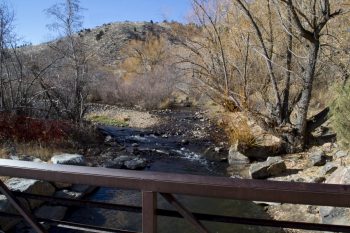









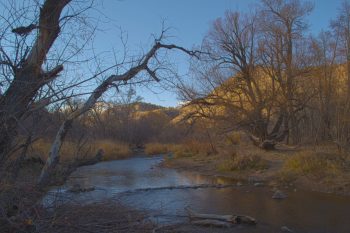
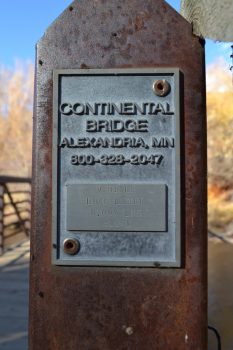


 s wish with some help.
s wish with some help.
There are quite a few trails leading off from Bear Creek Trail, almost all of them go to the water. One very interesting trail we explored had an arch made of plants that led down to a beach. The Creekside Trail does run along the creek as well, and is a nice short diversion from the other trails. However, there are many other unnamed trails to explore. Just be careful, since erosion can be a problem and damaging the wildlife isn’t anyone’s goal.
Also, the park had a sign that mentioned a problem with New Zealand Mud Snails. The sign warned anglers on how to sanitize their boots and clothing if they go in the water. Because of this, it would probably be a good idea to head this warning signs if you do travel down into the water. The snails themselves are tiny, only about 4-6 mm in length on average, and cause problems for the ecosystem.
To the left you can see Will standing under the arch on our way to explore the beach. After the beach we continued on and found a little deck that was a nice resting spot for Moses and also had some interesting information on the creek. Being so close to the Continental Divide, we sometimes take it for granted, but by definition, all the water on the east side of the divide flows into the Gulf of Mexico or the Atlantic Ocean. The creek here flows for 15 miles to the South Platte River, which flows for 650 miles until it merges with the Missouri River on the Nebraska-Iowa border, and from there it flows another 2,500 miles to the Gulf of Mexico. Thinking about the journey the water was going to take that we were playing around in was quite humbling. Below are a few pictures from the end of the hike.












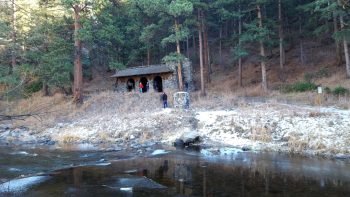
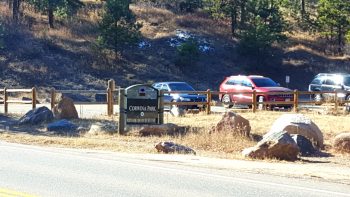
All things considered the park offers plenty of activities and diversions; from picnicking, to hiking, to mountain biking there is always something to do here. We’d recommend this for anyone wanting to get outside in a group with mixed abilities, as the trail is easy and almost anyone can do it. The options on distance are nice as well. Whether you want to take a long 12 mile hike or a short 1 mile jaunt along the creek, it’s all up to you. After your activity, we also recommend stopping in Morrison for some food and drinks. We particularly like the The Cow and they have a great happy hour. Cheers!

